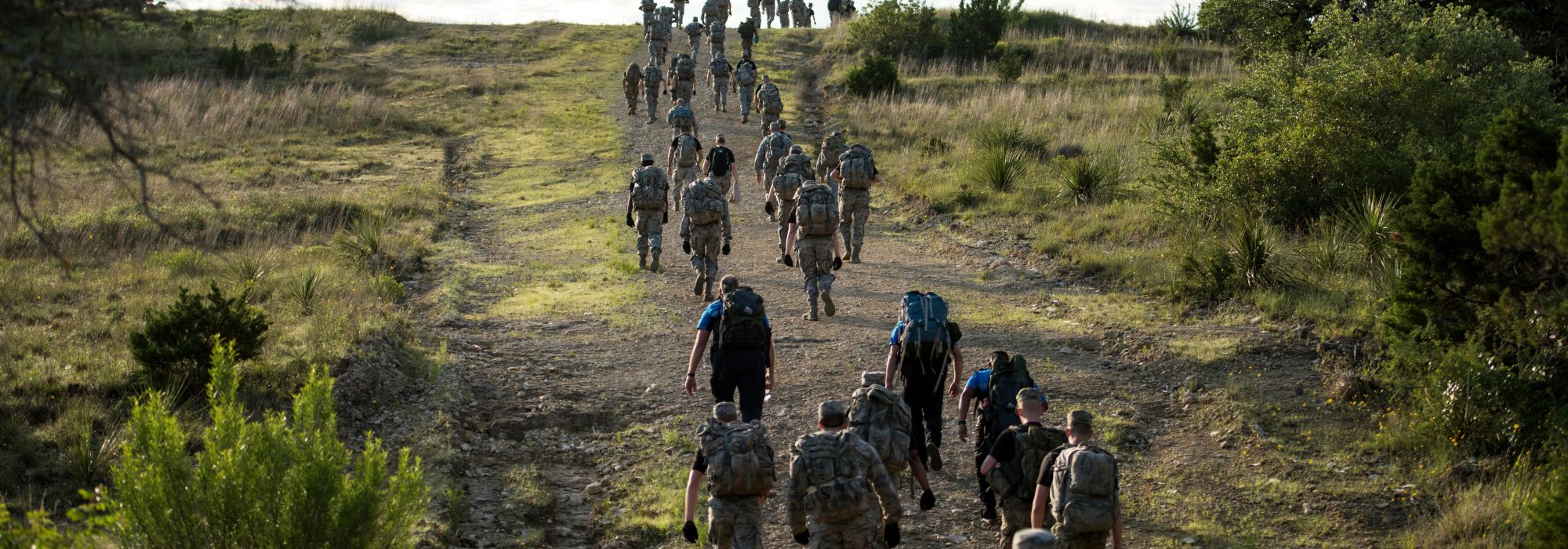
A SpaceX Falcon 9 carrying a GPS III payload lifts off from Cape Canaveral AFS, Fla., Dec. 23, 2018. The GPS mission is overseen by Air Force Space Command at Schriever AFB, Colo. Photo: SpaceX
PREPARING FOR FUTURE SPACE FLIGHTS
By Rachel S. Cohen
SCHRIEVER AFB, Colo.—More than 1,600 miles separates the 2nd Space Operations Squadron’s (SOPS) GPS team from the military space debates churning in Washington and while they don’t get the final say over what happens next for Air Force Space Command’s warfighters, they do control how they prepare.
GPS is just one of the missions run out of this base in the rolling hills near the Rocky Mountains, which also oversees operations for a range of communications satellites, surveillance, and weather systems, as well as the X-37B experimental space plane.
“The largest change we have seen to date is just a better understanding of how large space is, the competition in space, and how we need to be prepared for operating in what [may] no longer be a benign environment,” said Lt. Col. Stephen Toth, 2nd SOPS commander, in an interview. “We’ve started getting after training our operators in new and different ways … much more like the flying side of the Air Force.”
That means the 10 GPS operators on each shift now have to think about potential threats, possible avenues for attack, and adversaries they may notice either in orbit or within the systems they run. Is the anomaly on their screen just a blip, or is it enemy interference?
Ten years ago, that wouldn’t have crossed anyone’s mind, Toth said. Getting people to think differently about who or what they might face is a first step in preparing for future combat.
“We’ve started to fuse intelligence more into the space environment to give us a better understanding of what is out there, what we could see, and how we need to operate in and through that to continue to provide our capability to the warfighters or the civilian users, wherever they may be,” he said.
The pivot to a combat mindset began three years ago with the “Space Mission Force” initiative, which revamped training and started rotating staff through “ops floor deployments.” By framing their time in the windowless, screen-lined room as a combat deployment, they aim to show airmen they’re not just clicking buttons on a keyboard, but could find themselves in a fight.
“A lot of that training started with that intelligence fusion, by having intelligence personnel actually trained in space,” Toth added. “We’d be asking that individual who provides intelligence to an aircraft before it goes into theater to also provide some flavor of space intelligence. Now we have intel folks that are trained solely in space. … We can then use their information and knowledge to build realistic training scenarios.”
Qualification training today throws a range of threats at the GPS crew, forcing them to work through problems together. A recent report from the National Air and Space Intelligence Center pointed to anti-satellite missiles, lasers, jamming, cyber attacks, physical attacks on ground assets, and collisions with other objects in space as the most worrying issues.
So far, the 2nd SOPS hasn’t seen any of those in real life.
“We’re ready to execute the mission that we have right now,” Toth said. “In GPS, I’m 100 percent confident in the fact that we will not have any issues continuing this mission moving forward.”
He believes the Air Force will need to recruit more airmen for operational units as training evolves. The service will require more instructors, which would pull manpower from the ops floor, in turn growing the demand for personnel to fill in those spots while others are leading and attending training.
As US Space Command grows into a fully functional combatant command, Army, Navy, and Marine Corps space operations officers will naturally grow closer to the Air Force, Toth added. Bringing everyone together will help operators think outside their lanes and build a more holistic approach to space warfare.
“We are going to be bringing a lot of the best minds all together, kind of like how Strategic Command does it now, but with a sole focus on space and user capability on the ground,” according to Toth. “That’ll be a very good change. … The Army tends to deploy out into the field environment a lot and they really require a good use of space. Same with the Marines.”
Other personnel changes are on the horizon. At a Senate Armed Services Committee hearing, Air Force Chief of Staff Gen. David L. Goldfein suggested there could be new career paths for enlisted airmen—piloting the RQ-4 Global Hawk and performing space operations.
Enlisted space personnel will also go to the Air Force Weapons School for the first time this summer to bring back more tactical planning experience and insight to their units. Though officers and enlisted will largely learn the same material, 1st Lt. Morgan Herman, a weapons and tactics assistant flight commander, said the biggest difference is that enlisted trainees will dive into more technical details while officers get into operational specifics.
At the Space Foundation’s annual Space Symposium in Colorado Springs, Colo., Air Force Space Command chief Gen. John W. “Jay” Raymond said a new advanced instructor course for enlisted space warfighters will debut at Nellis AFB, Nev., this year. Six airmen will be in the first class.
“This new course will … provide advanced academic and tactical training for enlisted space professionals and is a stepping stone for incorporating our enlisted operators into the existing Air Force Weapons School,” he said. Enlisted airmen already serve as orbit analysts, engineering specialists, and more, and make up more than half of space operations crews.
“What we really want to do is get them to their full potential,” Toth said.
Enlisted airmen could eventually participate in navigation and bus payloads, orbital analysis, and nuclear detection.
About a dozen officers will soon graduate as the first class of “Schriever Scholars,” a new joint space warfighting concentration at Air University, and the Air Force is opening educational courses and training opportunities such as Space Flag to international partners.
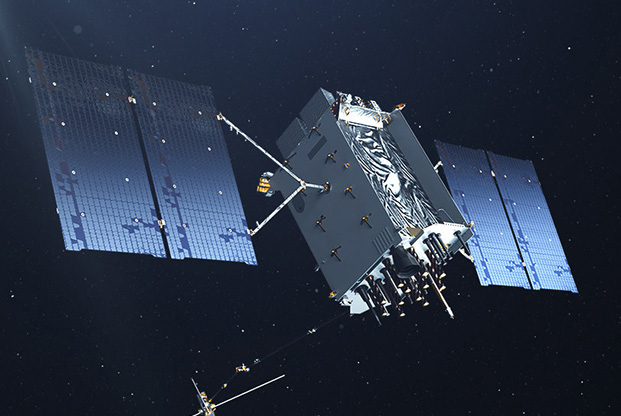
An artist’s concept of a GPS III on orbit. The next-generation satellite is said to be three times more accurate than the existing constellation and up to eight times more resistant to jamming. Illustration: Lockheed Martin
NEXT-GENERATION GPS
The first next-generation GPS III satellite went into orbit in December, circling the Earth in medium orbit 12,550 miles up. Built by Lockheed Martin, the new satellites are touted as three times more accurate than the existing constellation and up to eight times more resistant to jamming.
Improved GPS will allow military and civilian users to act on information faster, Lt. Col. Stephen Toth, 2nd SOPS commander, said. New automated software will alert operators to problems, send better data to people on the ground, and begin self-healing procedures automatically, said Capt. Ryan Thompson, the 2nd SOPS engineering flight commander.
“We understand the space environment better nowadays,” Toth said. “When you launched a [GPS] IIA into space 26 years ago, how well did you understand it? Now, with all the spacecraft going into space, we can build for robustness and really start to understand what it means to operate in space.”
“Where we are today, it’s way more exciting,” said Toth. “Our people are excited about it, they want to join the Air Force to get into space—which they weren’t doing 15, 20 years ago. They now see it as a future career option, and it shows in the people that we’re getting to do this job.”

An artist’s 1991 concept of a future space station. Almost three decades later, scientists are still researching ways to manufacture and assemble platforms in space. Illustration: Alan Chinchar/NASA
CHIEF SCIENTIST UPBEAT ON SPACE RESEARCH
By Rachel S. Cohen
The Air Force wants to be able to do more in space and its science enterprise is lining up to help. Air Force Chief Scientist Richard J. Joseph said the military has much to learn about manufacturing and assembly in space, the materials that could both enable and be reaped during space operations, and new ways of harnessing energy.
“I’m really upbeat about what I see,” Joseph said of recent developments in military-related space research. “I think they’re really leaning forward on thinking far enough ahead that we’re likely to be in good shape. And at the same time, we have people, of course, working today’s issues.”
Robotics could help assemble satellites in orbit, for example, potentially saving production and maintenance costs and reducing manpower needs.
“Rather than launching everything up whole, can we put things together?” Joseph asked. He speculated that the Air Force may want to deploy a manned assembly laboratory in space for that purpose.
Scientists are looking into potential improvements in the materials. Finding lighter materials may make it easier to fabricate parts on orbit, Joseph noted.
The Air Force could also “cannibalize” existing US satellites for parts.
Air Force leadership is open to new approaches in space manufacturing, including possibly reusing old systems, Joseph said.
Eventually, materials could even be mined directly on the moon.
“We believe there are plenty of interesting materials, metals, and such,” Joseph said. Without the burden of lifting all that weight off the Earth, it might be less costly to source materials in space. “What does a pound of titanium cost [to] put in [geosynchronous orbit], or in low Earth orbit, or in a [highly elliptical] orbit? What does that cost versus bringing it up from the ground?”
Where would the energy for moon mining come from? Or how would a directed-energy weapon get the power it needs? Air Force scientists are looking for answers.
“Our demand for power will go up, and up, and up, and we have all the same issues: How do we get rid of the heat? How do we transmit the power, and so on?” Joseph said. Power requirements will rise from tens of kilowatts or less, to hundreds of kilowatts, or even megawatts, he said. Scientists have been thinking about power in space for decades, but the research has not maintained its momentum.
“We stop and start, stop and start,” he said. “Sometimes stopping is a good thing. Sometimes we wait for technology to come catch up a little bit with the idea, with the goal. … We’ve been rejecting things because they were more than a few years out, and space power is one of those.”
HOLMES: WHAT ACC EXPECTS FROM NEW “CENTURY SERIES”
By John A. Tirpak
The Air Force will have more unique fighter programs in the coming years, but each will yield fewer airplanes than in the past, as the service moves toward a new “Century Series” of rapid development projects, Air Combat Command chief Gen. James M. Holmes said in an interview.
Instead of one big program numbering 1,500 aircraft that takes decades to field, Air Force acquisition chief Will Roper envisions a future where the Air Force develops and fields multiple different airplanes more quickly, but in lower volume.
“You’ll see programs that deliver a better capability now,” Holmes said. Then USAF will revisit them every couple of years to determine whether “we can we make that better.”
Some upgrades will be blended into existing production aircraft, while others will be embodied in entirely new aircraft. If a new platform is ready and more effective, he said, then “let’s stop producing what we were, and start producing these instead.”
In this plan, “you have multiple things in development, and you see which ones are a little bit better, and you shift your investments,” Holmes said. “You evaluate that routinely, instead of every 20 years.”
The original “Century Series” was a string of second-generation fighters developed in the 1950s and 1960s with designations F-100 through F-111. The jets were rapidly developed and fielded, but not expected to serve more than seven to 10 years before being supplanted by third- and fourth-generation aircraft.
The Air Force is seeking more than $1 billion for its Next Generation Air Dominance program in the 2020 budget request, and Holmes said the “Century Series” concept is built into that request. The model is “part of how you’re going to maintain an air advantage,” he said. “That can’t be static.”
The NGAD funding would pay for studies, prototyping, and experimentation.
Previous ACC commanders have discussed a Penetrating Counter-Air platform that might supplement or succeed the F-22 and F-35, but Holmes said that platform is only “one part” of NGAD, which he envisions as “a family of systems to be able to control the air and space.”
“It’s too early to say what’s going to show up,” Holmes said. The Century Series approach doesn’t require a plane be built to last 20,000 hours, opening up cost-saving options, he added. “You can build it in a different way.”
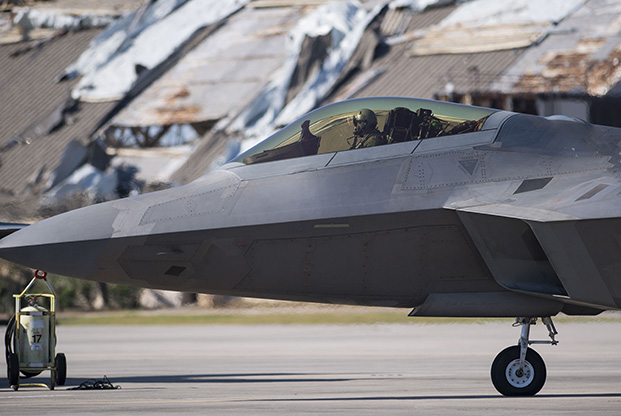
An F-22 readies for take off during Checkered Flag 19-1 at Tyndall AFB, Fla., in May. The F-22 fleet left Tyndall for other bases after Hurricane Michael, but F-35s are expected to arrive in 2020. Photo: A1C Monica Roybal
USAF OUTLINES 12-PART PLAN FOR TYNDALL REBUILD
By Rachel S. Cohen
The Air Force laid out a 12-part plan to rebuild Tyndall AFB, Fla., saying they are ready to hire someone to coordinate the work—if and when Congress is ready to pay for it.
Brig. Gen. Patrice A. Melancon, executive director of the Tyndall Program Management Office, said in an interview the scope of the rebuilding effort is so vast the service wants to hire a single contractor to coordinate and integrate the work across 12 zones, each defined by location and mission.
“We are looking to get a professional services contract to have an integrator, basically someone who is looking at all the different pieces and making sure they are synchronizing and that we’re not going to have a sidewalk that goes to nowhere, or we’re going to have a waterline that doesn’t connect up with a waterline from the other zone,” Melancon said.
The Air Force won’t issue any new contracts for the $5 billion restoration until Congress approves supplemental disaster-relief funding, which has been tied up in partisan disagreements. The House Appropriations military construction and veterans affairs subcommittee on May 9 approved?fiscal 2020?legislation that would allocate $1.6 billion to Air Force military construction, including $736 million for projects related to last year’s Hurricanes Florence and Michael.
The Air Force faces a multibillion-dollar shortfall to restore bases such as Tyndall and Offutt AFB, Neb., which were damaged by flooding in March. The service also recently proposed a pricey, long-term infrastructure improvement program.
The Air Force anticipates facility repairs at Tyndall will cost $1.4 billion, including about $550 million in fiscal 2019 and about $830 million in 2020.
Congress allowed the Pentagon to move $200 million to pay for those 2019 expenses, so a supplemental spending bill is needed to cover approximately $550 million in outstanding facility and non-facility expenses for Tyndall this year.Offutt also requires $420 million for recovery-related operations, maintenance, and construction, plus another $234 million for training devices.
The Air Force anticipates a long-term need for an additional $3.3 billion to completely restore Tyndall.
“If we initially only get enough money to do maybe two of the zones, that’s not a whole heck of a lot of integration involved in that,” Melancon said. “We are trying to figure out the right way to do sort of a base award for that design integrator, and then as we get more zones on, we will add capability to that design integrator because the more zones we have … the more effort it’s going to be.”
Another initial step will be finding a firm to start redesigning the base according to the new master plan and to help search for construction companies.
John W. Henderson, the Air Force’s assistant secretary for installations, environment, and energy, told reporters the plan shows a need to demolish more facilities than originally expected, but it also shows Tyndall can be laid out more efficiently.?
“While … I think we have well over 300 facilities now that are slated for demo or were destroyed in the storm, the build-back [plan] has significantly less than that because we were able to consolidate functions, we were able to make better use of the flight line, we were able to move non-flying functions off the flight line, and consolidate operations there,” Henderson said.
Air Force Magazine previously reported?rebuilding facilities that aren’t tied to a particular flying mission, such as housing and child care, are a top priority.
Melancon said that while the new master plan is in its final stages, officials are refining their requirements so they’ll be sure of what they need when lawmakers approve additional funding.
But Rep. John Garamendi (D-Calif.), chairman of the House Armed Services readiness subcommittee, indicated concern about rebuilding Tyndall in the same location.
“Storm surge is going to happen,” Garamendi told Air Force Vice Chief of Staff Gen Stephen W. Wilson during a hearing. “There are going to be Category 5 hurricanes in that area. … If you go back and build where it was destroyed, you’d better be able to tell us there’s absolutely no other place, and then you’d better build it for the worst possible case.”
The target date for the work to be completed is Oct. 1, 2023, when the first F-35s are scheduled to arrive on base. Tyndall also may receive a new MQ-9 mission after that as well.
Work needed to house fighter jets at new locations will account for about one-third of total military construction spending in 2020, according to the report accompanying the House Appropriations subcommittee bill. Building F-35A facilities at Tyndall is expected to cost $350 million, and it will cost $150 million to bring new training and operational squadron facilities to existing F-22 bases, as the Raptors relocate from Tyndall.
After the first Industry Day in January, nearly 70 contractors and academics submitted about 100 white papers with ideas for a new Tyndall, which the Air Force decided were either worthwhile, possibly beneficial despite some risk, or not the right fit.?
Submissions fell into six categories:
- Resiliency
- Smart basing
- Master planning concepts
- Contract acquisition
- Design and construction
- Project management.?
The service is moving forward with about half of the suggestions it received, and one-third require more exploration, Melancon said. One standout idea involves developing a suite of sensors that could alert maintenance staff when a building has a problem or when parts need to be replaced. Using the sensors for more proactive maintenance would help address issues earlier and avoid higher repair costs as facilities deteriorate further.
“We might be able to get an alert that says, ‘Hey, the motor in the No. 1 cooling tower, the vibrational pattern is off,’ ” Melancon said. “It might also be able to tell us, ‘Hey, by the pattern that we’re seeing, it’s probably a bearing problem.’”
The Air Force plans a gathering this summer to discuss the types of sensors it might need and how to harness data about the base once it’s collected. Plans to bring 5G wireless networks to the base also are underway, and officials are considering privately funded energy services, such as solar power arrays or microgrids. A third Industry Day is tentatively scheduled for August.
COST OF OFFUTT FLOOD RECOVERY WILL TOP $650 MILLION
By Rachel S. Cohen
Twenty facilities at Offutt AFB, Neb., cannot be saved in the wake of flooding that covered one-third of the base in March. But 10 other buildings can still be repaired, the Air Force said.
Key facilities housing the 55th Wing, 55th Operations Group, and 595th Command and Control Group headquarters, and others that support nuclear command, control, and communications aircraft and simulators, must be torn down and rebuilt, spokesman Ryan Hansen said in a May 9 email.
Among the buildings that can be salvaged are the E-4B Nightwatch hangar, intel facilities, and maintenance areas.
The cost of the damage will total about $420 million—$120 million for operations, maintenance, and facilities sustainment and $300 million for military construction. Another $234 million will be needed to replace training systems.
“We have transitioned the [Recovery Operations Center] into what we’re calling the NexGen Program Management Office,” Hansen said. “It is comprised of folks that are organizing subject-matter experts into a working group who’ll enable the wing to prioritize requirements. … This team will synergize our efforts to ensure the redevelopment of Offutt is done as efficiently as possible.”
Nearly 140 structures, including 44 occupied buildings, were flooded, Hansen said.
Facilities that must be rebuilt include:
- 55th Wing headquarters
- 55th Operations Group headquarters
- 595th Command and Control Group headquarters
- Satellite communications/MILSTAR Complex
- Aircrew alert campus for E-4B and E-6 aircraft
- 55th Intelligence Support Squadron facilities
- 343rd Reconnaissance Squadron facilities
- 625th Strategic Operations Squadron’s simulator facility
- 55th Security Forces Squadron’s combat arms training facility
- Veterinary clinic
- Petroleum operations facility
- Precision measurement laboratory
- Defense courier station
- Various electrical power substation utilities
- Tactical air navigation station
- Instrument landing system glide slope
- Recreation facilities
- Drug demand reduction facility
- Supply warehouses and equipment depots
- Hazardous waste storage facility
Facilities that can be repaired include:
- Bennie L. Davis Maintenance Facility
- E-6 ground equipment facility
- E-4B hangar
- 97th Intelligence Squadron facilities
- Recycling center
- Boundary fence
- Hydrant fueling facilities and utilities
- Munitions storage
- Vehicle fueling station
- Softball pavilion and storage
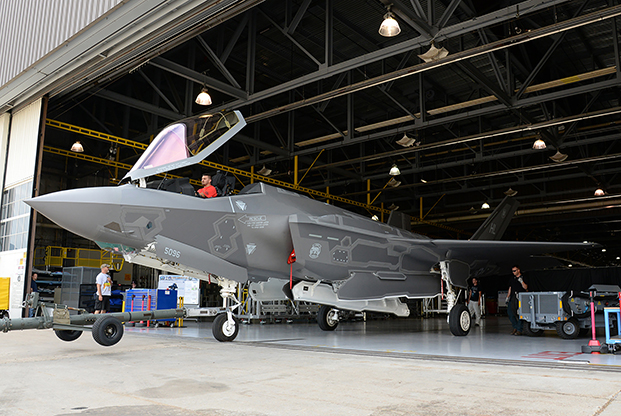
An F-35 is towed from a hangar at the Ogden Air Logistics Complex at Hill AFB, Utah. GAO says none of USAF’s depots are rated “failing,” but the average condition is “poor.” Photo: Alex Lloyd/USAF
GAO FINDS POOR CONDITIONS, DELAYED TIMELINES AT DEPOTS
By Brian W. Everstine
Three Air Force depots are plagued with expired equipment and have shown steadily decreasing on-time performance, prompting two of them to be listed in overall “poor” condition, the Government Accountability Office states in a new report.
The GAO evaluated all of the military service depots, including the Air Force’s Ogden Air Logistics Complex, Utah; Oklahoma City Air Logistics Complex, Okla.; and the Warner Robins Air Logistics Complex, Ga. The ratings largely focused on the age of equipment and overall health of the facilities.
Ogden, which performs depot maintenance on key fighter aircraft at a time when the service is working to increase readiness of these fleets, received the worst overall rating in the report. While no military depot was rated as “failing,” the average condition of the depots is “poor.”
The Air Force has said parts shortages at depots are a key reason for a drop in fighter readiness, but the GAO report also identifies the health of the depots themselves as an issue that needs to be addressed.
At Ogden, schedule performance has generally decreased over the past 11 years—down 20 percent from 2007 to 2017. While there was only data from fiscal 2018 to show the status of the complex’s facilities, in general it was rated to be “poor” and average equipment exceeded its service life by 12 years, the report states. In addition, repair requests have increased since 2009. As of 2017, Ogden had a backlog of about $259 million in restoration and modernization projects.
At Oklahoma City, schedule performance has remained stable, though the 2018 data of the facilities show them to be in a “poor” state. The complex’s equipment exceeds its useful life by an average of nine years, the report states. As of 2017, there was about $104 million in backlogged restoration projects.
The schedule performance at Warner Robins has decreased 30 percent over the past 11 years. The 2018 data of the facilities show them to be in a “fair” state, though equipment is exceeding its useful life by 13 years, the report states. As of 2017, there was a backlog of about $190 million in restoration and modernization projects.
While the Air Force, along with the other services, have begun to develop plans to improve the depots, the GAO states these plans lack analytically based goals, results-oriented metrics, identification of required resources, and adequate reporting on progress. The GAO recommended the Air Force address these shortfalls, and the Pentagon agreed to those recommendations.
However, the Defense Department said it needs to wait until these plans are completed before it can develop an approach to manage and program future investments.
NOMINATIONS ANNOUNCED
President Donald J. Trump has nominated USAF Maj. Gen. Eric T. Fick for a third star and appointment as director of the F-35 Joint Strike Fighter Program. Fick currently serves as the office’s deputy director, and if confirmed he will replace Vice Adm. Mat Winter, who led the JPO since May 2017.
Trump also nominated Air Force Special Operations Command boss Lt. Gen. Marshall B. “Brad” Webb to be commander of Air Education and Training Command. If confirmed, he will take over for Lt. Gen. Steven L. Kwast, who has led the command since November 2017. The Air Force has not announced Kwast’s next position.
The Senate has confirmed Lt. Gen. James C. Slife to replace Webb at AFSOC. Slife previously served as the vice commander of US Special Operations Command.
Maj. Gen. David S. Nahom has been nominated for his third star and to be deputy chief of staff for strategic plans and programs. He is currently the director of programs for the deputy chief of staff of plans and programs. If confirmed, he will replace Lt. Gen. Jerry D. Harris Jr. The Air Force has not announced Harris’s next position.
Lt. Gen. (sel.) Marc H. Sasseville was tapped for a third star and assignment as commander of US North American Aerospace Defense Command Region and 1st Air Force (Air Forces Northern). Sasseville currently serves as deputy director of the Air National Guard.
THE STRATEGIC IMPLICATIONS OF HYPERSONIC WEAPONS
By Rachel S. Cohen
As the Pentagon moves ahead in its pursuit of hypersonic weapons, the defense community has mixed opinions on whether the new missiles should be considered as strategic assets—because simply owning them should dissuade adversaries from using their own.
Adding hypersonic weapons to the inventory could affect the broader strategic deterrent as the nuclear triad is modernized in the coming decades.
USAF Gen. Paul J. Selva, Vice Chairman of the Joint Chiefs of Staff, said hypersonic weapons would be incredibly versatile in both conventional and nuclear conflicts.
“The best layman’s description I’ve heard of hypersonics as a strategic threat goes something like this: If you’re going Mach 13 at the very northern edge of Hudson Bay, you have enough residual velocity to hit all 48 of the continental United States,” Selva said April 25. “You can choose … to make a right or a left turn and hit Maine or Alaska, or you can hit San Diego or Key West. That’s a monstrous problem.”
On the other hand, Pentagon research chief Mike Griffin told reporters last July he views hypersonic missiles more as tactical weapons, not strategic.
Hypersonic weapons could fly one mile per second and take 15 minutes or less to reach a target, compared to about half an hour for a ballistic missile. But James M. Acton, co-director of the Carnegie Endowment for International Peace’s Nuclear Policy Program, says a hypersonic missile would move slower when approaching its target than a ballistic missile at the same range.
The Air Force aims to develop hypersonic weapon prototypes in the next few years under rapid development and acquisition partnerships with the Defense Advanced Research Projects Agency, its sister services, and Lockheed Martin. Some have speculated that development should run parallel to the Pentagon’s broader nuclear modernization effort.
“Don’t presume that what you modernize in this next five to seven, eight, 10 years stays the same for the rest of its deployed life,” former 20th Air Force commander retired Maj. Gen. Roger W. Burg, who now runs O’Malley Burg Consulting, said at an AFA Mitchell Institute breakfast. “Hypersonics are going to have to be part of the nuclear deterrent of the future.”
Hypersonics’ role in projecting strategic power depends on how the military defines how they will be deployed. Possible missions include preemptively disabling rogue states’ nuclear infrastructure or attacking anti-satellite weapons before they could be used, Acton said.
“I’m not sure we’ve got a clear concept of operations,” Acton said in a May 6 interview. “A lot of this is developing technology for the sake of technology and trying to work out what to do with it later. To the best of my knowledge, we’ve never articulated precisely what mission need hypersonics are supposed to fill.”
Hypersonics could pose tactical conundrums as well, according to Selva, such as in a “launch under attack” scenario like those considered during the Cold War. The US has to consider what it means to add weapons that would go undetected by current missile-warning systems, he said.
“We see a thousand missiles coming our way, we got a thousand missiles pointed their way, it’s the end of the world as we know it. … Some modicum of the nation survives, we live to fly and fight another day,” he said. “Hypersonics really complicate that problem in some really difficult tactical and operational settings. We have to figure out how to adjust to those.”
Acton disputes that fielding American hypersonics will directly offset Russian or Chinese hypersonics, and that the US shouldn’t pursue the capability simply because its rivals are.
He argues a conventional hypersonic missile strike would be 100 or 1,000 times less powerful than a nuclear one and that such comparisons of hypersonic and nuclear weapons are “totally misleading.”
“Nevertheless, I would still class certain kinds of hypersonic weapons as strategic,” he said. “In particular, we have a lot of military hardware deep in the US that we’ve never had to worry about being attacked with conventional weapons before. … If Russia or China had the ability to reach out over very long distances and threaten that kind of critical military infrastructure within the US, that’s a pretty significant development.”
Yet, while he said very long-range hypersonic missiles could be considered strategic, he added, putting a nuclear warhead on them wouldn’t necessarily be a game-changer because the US is already vulnerable to a nuclear attack.
“I just don’t see hypersonics displacing the kinds of things we would think about using nuclear weapons for,” Acton said. “They’re just completely different categories. … I don’t think we can get rid of some nuclear weapons because we in some way substitute or replace them [with] hypersonics.”
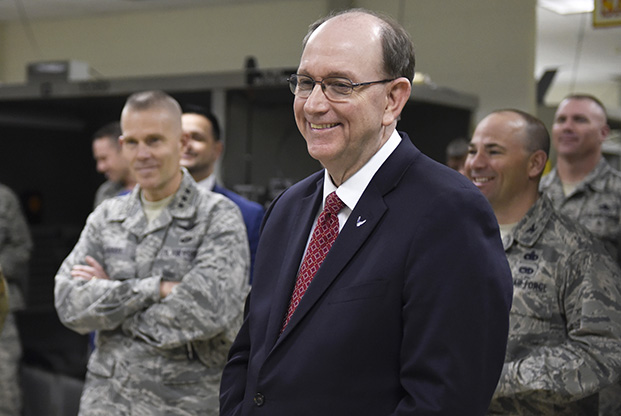
Undersecretary of the Air Force Matthew Donovan visits Sheppard AFB, Texas, in February. Photo: A1C Pedro Tenorio
DONOVAN TO BECOME ACTING SECAF JUNE 1
Air Force Undersecretary Matthew P. Donovan will take over as Acting Secretary June 1 after Secretary Heather Wilson steps down, the Pentagon announced May 15. The announcement makes official—what has been expected —since Wilson announced her intent to become the next president of the University of Texas-El Paso.
Donovan took over as undersecretary of the Air Force in August 2017. He was previously the major policy director for the Senate Armed Services Committee, and he is a former command pilot with more than 2,900 flight hours in the F-5E and F-15C.
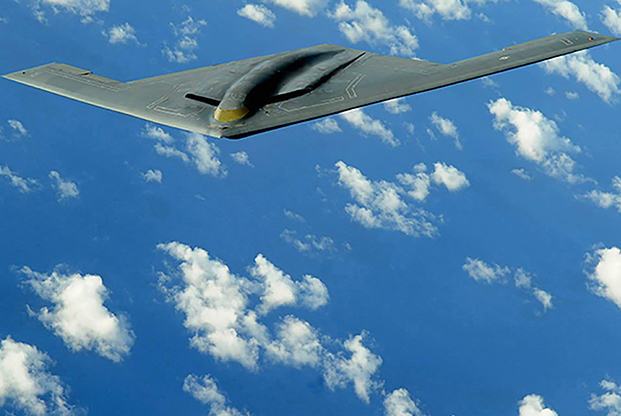
An artist’s concept of a B-21 Raider. Staff illustration by Mike Tsukamoto
UNDECIDED: HOW MANY B-21S
By John A. Tirpak
The head of Air Force Global Strike Command says it’s too soon to decide how many B-21 Raiders to build.
Gen. Timothy M. Ray said AFGSC developed its Bomber Vector before the new National Defense Strategy was written, and development of the B-21 is still too premature to commit to a specific number.
“My job … is to keep as many options on the table as long as I possibly can,” Ray said. The B-21 will not transition from development to production of the initial test aircraft until 2024. Committing to a number before that point would be “gambling,” Ray said.
Still, Ray acknowledged buying more planes faster will ultimately be less costly than buying more slowly.?
To build out the fleet faster is cheaper,” he said. “But like anything, you pay more up-front” to get high-capacity production.
The Bomber Vector said the B-2 and B-1 would start phasing out around 2031, because the bulk of the B-21 fleet would be delivered by then. A fleet of 100 bombers delivered over seven years translates to production of fewer than 14 per year, since at least some early test versions are expected to be converted for operational use. ?
Ray said the Air Force learned from the B-2 and F-22 programs, where it invested in mass production capability only to buy fewer aircraft than expected, leaving high unit costs.
In addition to the National Defense Strategy, the Bomber Vector also predated a number of studies that concluded the service will need more bombers. Those include The Air Force We Need analysis released last fall and studies by the Center for Strategic and Budgetary Assessments, Mitre Corp., and AFA’s Mitchell Institute for Aerospace Studies. “Every indication is that the bomber force needs to grow,” Ray said.
“Every indication is that the Air Force will be at the forefront of any conflict of any dimension, Ray said.
The bomber force is “under-invested” in hypersonics, counterspace, and counter-maritime capabilities, and Ray said he needs to “close some of these gaps.”
The Air Force has said it needs “at least” 100 B-21s, but Ray said, “I shouldn’t come to Congress, or the Secretary, or the American people and say the answer to this is to simply print me 250 B-21s. We need a minimum of 100, but the decision to make that move is in the outyears.”
B-21 flight testing will get underway in 2021, Ray said, and USAF anticipates receiving a number of jets as a test fleet in that period.
“I’m confident [cost] numbers are going to be very favorable, because cost is a KPP [key performance parameter],” Ray said, adding that the critical design review was favorable for the B-21.
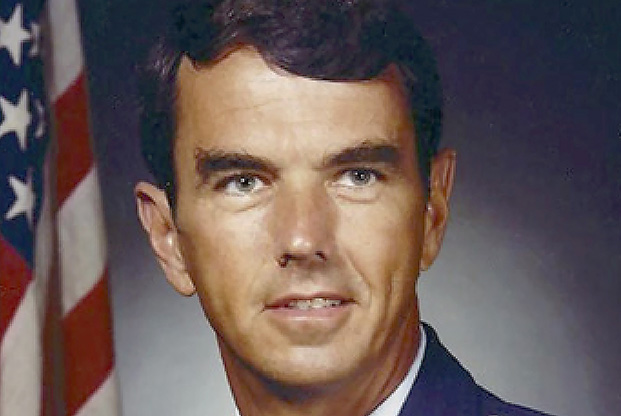
Col. Philip Conran. Photo: USAF
PUSH TO UPGRADE VET’S AIR FORCE CROSS TO MEDAL OF HONOR
By Brian W. Everstine
The heroic actions of a USAF special operations helicopter pilot who saved multiple Americans during a secret 1969 mission in Laos are getting a fresh look as a Congressman urges the Pentagon to upgrade an Air Force Cross to the Medal of Honor.
Retired Col. Philip J. Conran, then a pilot with the 21st Special Operations Squadron based in Thailand, received the Air Force Cross for a mission on Oct. 6, 1969. During a helicopter mission into Laos, the lead helicopter was shot down and a rescue helicopter, designated H-1, refused a request to reach the downed crew, saying it was too risky.
Conran, then a major, was ferrying troops in his CH-3 Jolly Green Giant and faced two choices: “Depart the area leaving his downed comrades or attempt a rescue and reinforce the friendly troops already on the ground,” the Air Force Cross citation states.
Conran tried to rescue the crew, “since he felt his comrades would not survive the overwhelming enemy forces.” As the Jolly Green Giant began its approach, the helicopter’s servos were destroyed, but he made the landing, letting off the troops he was carrying and picking up the four Americans from the downed helicopter. Attempting to take off, enemy fire destroyed the helicopter’s transmission, making flight impossible.
The team fled the helicopter, and Conran took command, exposing himself to enemy fire to set up a perimeter. He ran back to the CH-3 to pick up packaged parachutes to use as cover, and then ran 50 yards through enemy fire to get two M60 machine guns and ammunition from the downed helicopter. As the day went on, Conran called in air strikes, using a pocket compass to help direct the fires. Eventually he received a severe leg wound, but he remained a “source of energy” to the rest of his team. As night fell, the area “was completely sanitized with gas,” and two HH-53 helicopters were able to land to rescue the downed crews.
Even though he was severely wounded, Conran got down on his hands and knees so another man could use his back as a stepping stone to get onto the aircraft.
“Major Conran’s decision to come to the aid of his downed comrades, his heroic actions above and beyond the call of duty while under severe hostile fire, and his outstanding leadership throughout the many hours were instrumental in enabling them to withstand the superior enemy force,” the citation states.
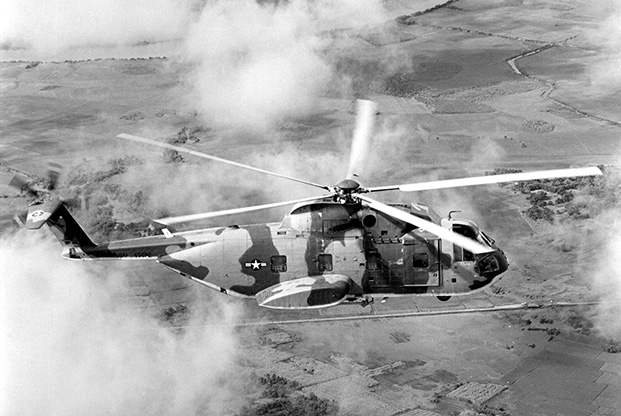
A CH-3 Jolly Green Giant flies over Vietnam. Photo: USAF
Rep. Salud Carbajal (D-Calif.) introduced a bill in April to authorize the president to award Conran the Medal of Honor.
“Conran served our nation with the utmost bravery during the Vietnam War when he risked his own life in combat to save his fellow soldiers,” Carbajal said in a statement. “It has taken far too long for our country to honor his courage, and I will continue working to help secure this well-deserved recognition.”
Carbajal also provided two eyewitness accounts from others on the mission to the Air Force Decorations Board to bolster the case for an upgrade.
In one of the statements, a gunner from the helicopter that was shot down said he owes his life to Conran. “Before he joined us on the ground, I didn’t think we would survive the day,” he said. The reinforcements from Conran’s helicopter and his leadership helped them “withstand the onslaught” of enemy fighters, and Conran’s decision to get on his hands and knees to help another soldier was a particularly “heroic act” “that still impresses me,” said the gunner.
In the other statement, the mission commander of the helicopter that was shot down wrote that Conran deserves the Medal of Honor because he was willing to sacrifice his own life for his downed comrades. “I know I lived to see another day because Conran risked his life to save me and my crew,” he said.
The aircraft commander wrote that at the time, politics prevented Conran from the recognition he deserved because the US did not admit publicly that US forces were operating there.
“We were in a place we should not have been, doing what our country asked us to do, yet we were treated different from those in open combat when it came to recognizing our accomplishments,” he wrote. “In war, some secret missions can’t be discussed until enough time has passed so as not to embarrass the nation. In this case, there is no excuse not to bestow this honor on a deserving warrior.”
The military has in recent years upgraded several valor awards to the Medal of Honor, including to members serving in Laos. In 2010, former President Barack Obama awarded the Medal of Honor posthumously to CMSgt. Richard Etchberger, who originally received the Air Force Cross. Like Conran, Etchberger was deployed to Laos, where he was killed during the Battle of Lima Site 85.
Last year, MSgt. John Chapman’s Air Force Cross was upgraded to the Medal of Honor, and a Navy Cross awarded to Marine Corps Sgt. Maj. John Canley was also upgraded to the Medal of Honor.
There is also precedent for Congress passing a law to upgrade an award. In 1999, then-Rep. John Boehner (R-Ohio) introduced a measure to upgrade the Air Force Cross awarded to A1C William Pitsenbarger to the Medal of Honor. The measure was approved as part of the next year’s Defense Authorization Act, and the award was presented to Pitsenbarger’s family in 2000.
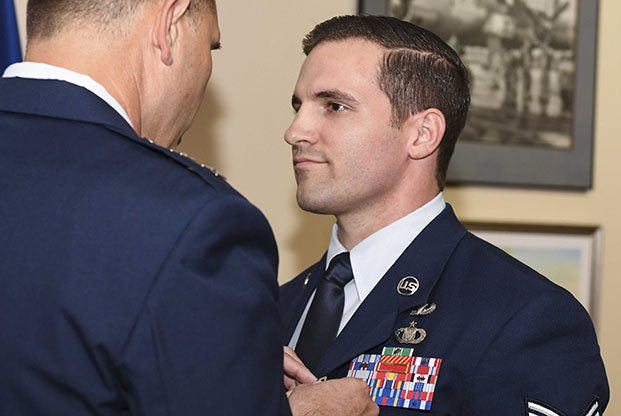
TSgt. Cam Kelsch receives a Silver Star Medal from Maj. Gen. Vincent Becklund during a ceremony at the Mighty Eighth Air Force Museum in Georgia April 9. Photo: SrA. Rachel Yates
TWO VALOR AWARDS FOR TACP
By Brian W. Everstine
An Air Force tactical air control party airman received both the Silver Star and Bronze Star medals—both with Valor—for two separate missions during a single deployment to Afghanistan last year.
TSgt. Cam Kelsch, assigned to the 17th Special Tactics Squadron at Fort Benning, Ga., was deployed with the Army’s 75th Ranger Regiment on April 25, 2018, when his team was tasked with tracking down a high-value target during a night raid in Afghanistan.
When the unit came under attack, Kelsch exposed himself to the fire and called in strikes from an AC-130 circling above, which used its 40 mm cannon to attack targets within 40 meters of the team’s location.
“There’s one thing that Cam had that day that we can’t teach, instruct, or measure,” said Maj. Gen. Vincent K. Becklund, deputy commander of Air Force Special Operations Command, during a ceremony at the National Museum of the Mighty Eighth Air Force in Pooler, Ga. “The reason we’re here today is because Cam distinguished himself on the battlefield that night through his courage, his selflessness, and his devotion to his teammates.”
Wounded as he dragged a fellow US service member to safety, saving his life, Kelsch continued to call in strikes on more targets about 70 meters away, according to the citation.
He then called on an unidentified ISR aircraft to coordinate simultaneous 500-pound bombs from an F-16 and 105 mm cannon blasts from the AC-130 to take out a final enemy location.
Kelsch also received the Bronze Star with Valor for an undated mission during which he placed himself between an enemy location and his team’s wounded ground force commander.
With enemy in “immediate proximity,” Kelsch eliminated that threat and helped his ground commander recover, according to the citation.
F-35A MAKES COMBAT DEBUT
By John A. Tirpak
The Air Force’s F-35A Lightning II made its combat debut on April 30, releasing a Joint Direct Attack Munition against an ISIS tunnel network and weapons depot in Wadi Ashai, Iraq.
The target was located in the Hamrin Mountains and was in a position to “threaten friendly forces,” according to AFCENT.
This is the first Middle East deployment for the Air Force’s F-35A, and while the operation apparently involved two F-35As, only one released a weapon. The strike fighters deployed to Al Dhafra AB, United Arab Emirates, from the 4th Fighter Squadron at Hill AFB, Utah, just two weeks prior. The jets previously deployed to Europe and Japan. The F-35A was declared operational at Hill in the summer of 2016.
Lt. Col. Yosef Morris, 4th Fighter Squadron commander, said the F-35 is already making a significant contribution to USAF missions in the AOR.
“We have the ability to gather, fuse, and pass so much information, that we make every friendly aircraft more survivable and lethal,” he said in a press release.
AFCENT released images of an F-35 being refueled above an undisclosed location on the day of the mission. The aircraft carried two AIM-9X air-to-air missiles on outboard stations, so if the jet in the image carried out the attack, it was not in “stealth mode,” which would have contained all ordnance internally. No unit markings were visible in the images.
Morris, in the release, said the F-35 has “sensors everywhere, it has advanced radar, and it is gathering and fusing all this information from the battle space in real time.” He said the jet can share that information with “other F-35s or even … fourth- generation aircraft in the same package that can also see the integrated picture.”
A Marine Corps F-35B that was deployed to Afghanistan last September also released ordnance on a target. Previously, Israel had reported that an F-35A from its air force had released live ordnance against an enemy target.
T-6 CRASHES, PILOTS EJECT
By Brian W. Everstine
A T-6 training aircraft from Sheppard AFB, Texas, crashed May 1 in Oklahoma during a training flight. The pilot and co-pilot were able to safely eject.
Sheppard is the Air Force’s largest training base and is the home to the 80th Flying Training Wing, which trains both Air Force and NATO pilots. The 89th and 459th Flying Training Squadrons fly T-6s.
The crash is the latest in a series of incidents involving the aging Texan II, including a Sept. 19 crash of a T-6 from JBSA-Randolph, Texas. The pilots in that incident also were able to eject and sustained minor injuries.
The fleet has been plagued by issues with its on-board oxygen system, leading to a stand-down in early 2018. The pause had a significant impact on the Air Force’s ability to train pilots. The Air Force Physiological Episodes Action Team has recommended that USAF stand up new program offices to monitor and slash the number of hypoxia-like incidents in its trainer and fighter fleets, as it overhauls the On-Board Oxygen Generations Systems on the Texan IIs.
USAF is conducting an investigation to determine the cause of the most recent incident.
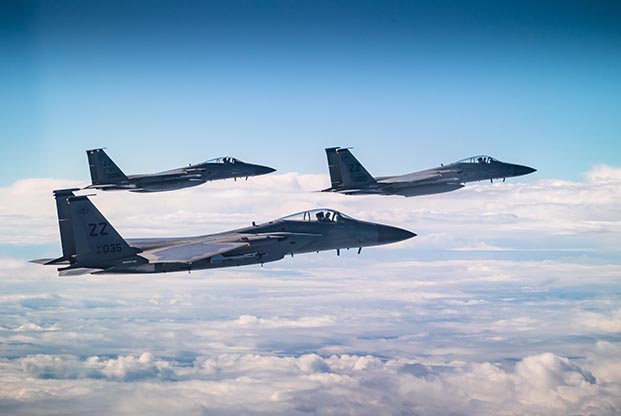
F-15Cs fly in formation over the East China Sea during a routine training exercise out of Kadena AB, Japan. Photo: A1C Matthew Seefeldt
PILOT ERROR CAUSED 2018 F-15C CRASH
By Brian W. Everstine
An F-15C pilot’s improper maneuvers during a June 2018 training flight near Kadena AB, Japan, caused the Eagle to enter into an uncontrollable spin and crash into the sea, according to a Pacific Air Forces accident investigation.
The pilot, who was assigned to the 44th Fighter Squadron at Kadena, sustained serious injuries after ejecting, and the aircraft was destroyed at a loss of $42.3 million.
While dogfighting with an F-22 from the 525th Fighter Squadron at JB Elmendorf-Richardson, Alaska, the pilot conducted a steep, sharp vertical maneuver and then experienced a significant nose drop, entering a dive, and turning right. This created a harsh G force change, snap roll, and started an inverted spin.
The pilot, whose name has not been released, attempted to eject, but initially failed because G forces had him pinned to the side of the cockpit. After a second attempt, the pilot was able to eject 15 seconds after losing control of the jet. The F-15 was at about 1,100 feet above sea level, well below its minimum ejection altitude of 6,000 feet.
Uncontrolled ejection altitudes are set based on the seat’s capability and potential for the ejection to occur in extreme conditions. Because of the low altitude, and the fact the pilot ejected while in a spin, the pilot impacted the sea at a high speed and was injured.
The pilot’s survival locator beacon failed and did not transmit his location. However, the F-22 was able to locate the crash site and transmit the location to Kadena’s tower, and the pilot was rescued by a Japan Air Self-Defense Force UH-60J helicopter from Naha airport.
The PACAF investigation found the main cause of the crash was the pilot’s improper application of forward stick with full right rudder, causing the negative G departure from controlled flight. Contributing factors included spatial disorientation, as well as a lack of emergency procedure training for negative G departures from controlled flight and a limited time to analyze the situation and recover.
Following the incident, Kadena’s 18th Operations Group changed its training to give pilots more “decision time” in similar situations in the future.
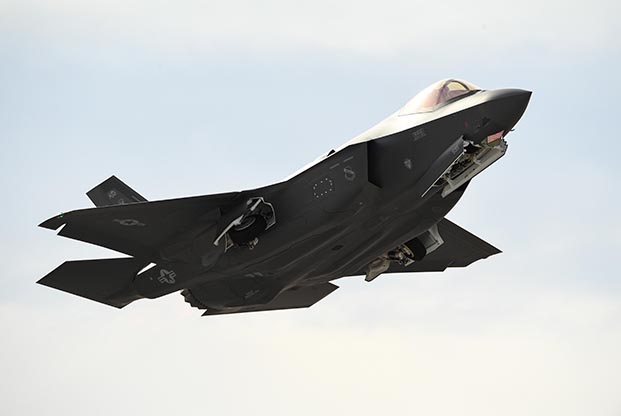
An F-35 takes off from Nellis AFB, Nev., in February. Photo: R. Nial Bradshaw/USAF
F-35 AGGRESSORS AT NELLIS
By Brian W. Everstine
The Air Force is bringing back the 65th Aggressor Squadron at Nellis AFB, Nev., and equipping it with F-35s to provide enhanced training for other fifth-generation aircraft. Nine non-combat capable F-35As from Eglin AFB, Fla., will move to Nellis once newly produced aircraft can backfill them, beginning in early 2022.
Two more F-35s will move from Edwards AFB, Calif., to Nellis to join the 24th Tactical Air Support Squadron, which now flies F-16s to conduct close air support training. The two new aircraft will allow for additional CAS training with F-35s.
The 65th Aggressor Squadron flew F-15s for nine years as mock adversaries for pilots in the US Air Force Weapons School and at exercises such as Red Flag, before it was inactivated in 2014 due to budget cuts. Since then, the 64th Aggressor Squadron has been the sole USAF provider of Red Air at Nellis, with the 18th Aggressor Squadron flying Red Air at Eielson AFB, Alaska. Draken International also has provided Red Air at the base since December 2015, and the Air Force is looking to significantly increase the amount of contractor-owned and operated aircraft that fly as aggressors.
FAIRCHILD TO RECEIVE KC-135S
The Air Force is restructuring its KC-135 fleet as it brings on more KC-46s, moving 12 of the legacy tankers from McConnell AFB, Kan., to Fairchild AFB, Wash.
The 92nd Air Refueling Wing at Fairchild will be the new home to the KC-135s beginning in fiscal 2020, a shift that will add 1,000 airmen and families to the base, according to a Fairchild release. The move will necessitate the reactivation of Fairchild’s 97th Air Refueling Squadron—which was inactivated in 2004—and related maintenance unit.
McConnell will be the first main operating base for the KC-46.
THE WAR ON TERRORISM
Casualties:
As of May 15, 71 Americans had died in Operation Freedom’s Sentinel in Afghanistan, and 79 Americans had died in Operation Inherent Resolve in Iraq, Syria, and other locations.
The total includes 145 troops and five Department of Defense civilians. Of these deaths, 69 were killed in action with the enemy while 81 died in noncombat incidents.
There have been 396 troops wounded in action during OFS and 81 troops in OIR.
